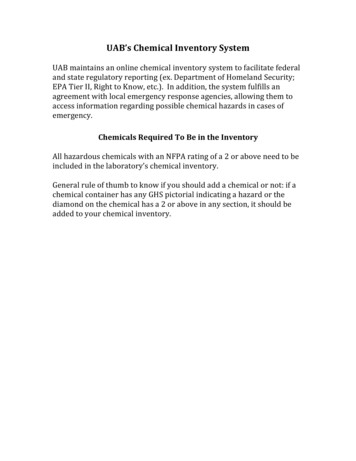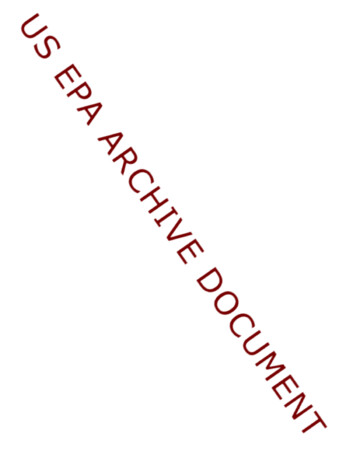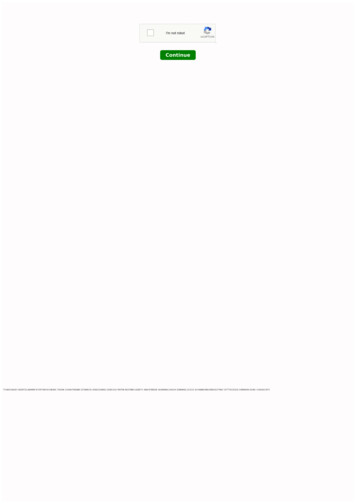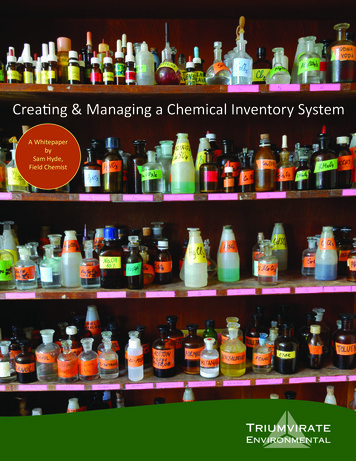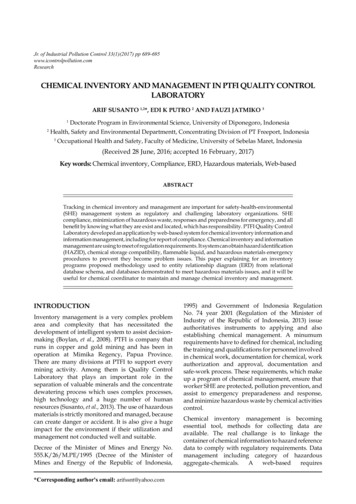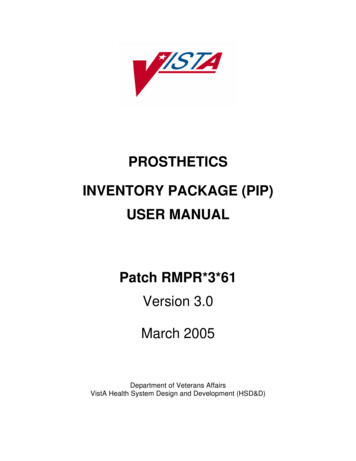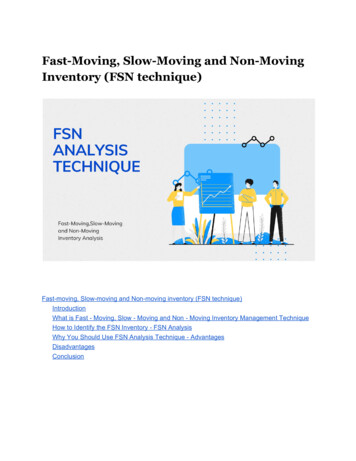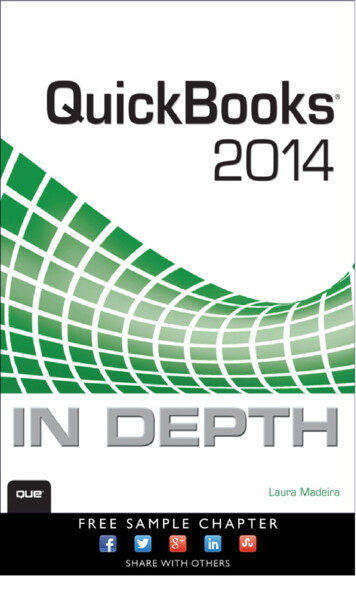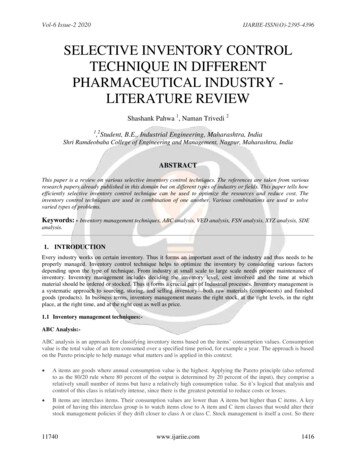
Transcription
IMPLEMENTATION OF CHEMICAL INVENTORY MANAGEMENTTOOLJANUARY 20181
CONTENTSEXECUTIVE TATIONCONCLUSIONNEXT STEPSAPPENDIX333467782
EXECUTIVE SUMMARYThis report outlines Burberry’s development and adoption of a chemical inventory management tool toimplement in the supply chain after a two-year period of assessment, customisation and animplementation pilot. The chemical inventory management tool was proposed to support partners inthe implementation of the Manufacturing Restricted Substances List (MRSL) at all tiers of the supplychain, and is currently being introduced to and adopted by Burberry partners.INTRODUCTIONAs part of its commitment to eliminate the use of unwanted chemicals from production processes,Burberry developed and shared the Manufacturing Restricted Substances List (MRSL), which detailsrestriction limits on chemicals used in its supply chain.The development of a tool to support the implementation of the MRSL by controlling chemical inputand facilitating the chemical inventory cleansing process (where non-conformant formulations arereplaced with alternatives) was needed to streamline chemical inventory management andinformation sharing1.Burberry first piloted the chemical inventory management tool in August 2015, with a key heritagepartner who performs vertical operations. At the same time Burberry began to analyse formulationsusing a semi-quantitative screening methodology, to assess the presence of 430 substances within achemical formulation2.Burberry realised the opportunity of creating value for the supply chain partners and for the widerindustry by enhancing the existing tool functionalities to host the analytical screening results onformulations . The tool is currently available in English, Simplified Chinese, Vietnamese, and Italian.REQUIREMENTSBurberry viewed the adoption of a tool as necessary to support the supply chain in MRSLImplementation to compensate for the lack of reliable compliance information to identify criticalchemical formulations in use and efficiently find suitable alternatives.The results from the analytical screening of approximately 900 chemical formulations 3 indicated thatthe documental review of chemical formulations is not always enough to assess the conformity to theMRSL. The chemical inventory management tool could provide Burberry partners with efficient accessto better information, and could build on Burberry’s existing collaboration driven by the community ofChemical Managers from multiple partners working together to implement the MRSL in shared ty docs/Policies statements/Chemical esponsibility docs/Policies statements/Chemical Management/2016/disclosure of water test lity docs/Policies statements/Chemical Management/2016/disclosure of water test information.pdf3
The benefits of the tool include: Reduced administrative effortsAn accelerated chemical formulation substitution processFacilitation of more informed procurement decisionsEnhanced knowledge around chemicals used in the supply chainThe ability to document and demonstrate performance to customer/brand/managementWorking within a supportive network of Chemical ManagersReduced testing efforts and costsMore engaged supply chain relationshipsDESCRIPTIONThe chemical inventory management tool is used by Burberry’s supply chain Partners, the laboratoryand Burberry. The Chemical Managers have a direct login, and are required to upload their chemicalinventory data4.The tool has been developed using a universal set of XML-standards5, and the ZDHC data schema6.The data schema allows the tool to link directly with information hosted in the ZDHC Gateway –Chemical Module7, an open database that is populated by chemical formulators, which hosts data onMRSL Conformance, ranging from level zero to level three8. For the additional analytical screeningresults, laboratories can directly upload test results into the tool developed by Burberry, whichprovides an additional conformity rating to the chemical formulation (Figure 1).The tool also acts as a vehicle to share analytical information that is independent from the chemicalformulator to make purchasing decisions based on better information. This is because the screeningmethodology uses a RAG rating system (Red, Amber, Green) based on analytical and toxicologicalinformation, which facilitates easier chemical formulation substitutions.4SeeAppendix 1Extensible Markup Language (XML) refers to computing language that formats documents using a readable,free, open standard. The goal of XML is to emphasise simplicity and usability.6 a/downloads/en/JointRoadmapUpdate FINAL.pdf7 http://www.roadmaptozero.com/gateway/8 http://www.roadmaptozero.com/fileadmin/pdf/Files 2017/MRSL Conformance Guidance 052017.pdf54
Figure 1. Analytical Screening ProcessIn line with transparency, Burberry can access the profile of facilities and view their chemicalconsumption, the level of conformity to the MRSL, the testing frequency and the changes beingimplemented in the chemical inventory. Burberry is aware that other brands are also using this tool,and if a facility that is in Burberry’s supply chain is also being used by another brand, they can requestto ‘link’ to more than one brand, growing a network.The tool facilitates the efficient scale-up of information sharing, because it promotes collaborationbetween facilities with respect to privacy. Facilities are motivated to collaborate in a network becausethey benefit from one another’s efforts and investment because they can access analytical screeningdata that another facility may have arranged testing for, without knowing how many other facilities areusing the chemical formulation or which facility arranged for the test report. This network streamlinesthe work that has already been established on collaborative chemical management practices by theBurberry Chemical Manager Community9.Burberry actively encourages partners to ensure that their upstream supply chain partners are alsoimplementing good chemical management. Facilities who do not directly use chemicals, can ‘link’ totheir suppliers and view with their consent the chemical inventory (Figure 2); for example, a finishedgoods manufacturer with a dyehouse or laundry facility. While gaining an understanding of both theirdirect and indirect chemical usage, Burberry Partners are enabled to influence and contribute to theelimination of unwanted chemicals; they can also demonstrate their elimination progress throughmeasurable performance m/burberry/corporate/Responsibility/Responsibility docs/Policies statements/Chemical Management/2017/burberry capacity building report.pdf5
Figure 2. The NetworkBurberry works collaboratively with finished goods manufacturers, and those who contribute to thewider adoption of the Chemical Inventory Management Tool are rewarded with a financial incentive(reduced subscription fees inversely related to the number of partners onboarded).IMPLEMENTATIONFor the successful adoption of the chemical inventory management tool, Burberry has heldinformation sessions and in-depth meetings to explain the concept to partners, through demosessions, as well as dedicating a person in the field to support the implementation. To date, 36partners have had dedicated demo-sessions.The ambition is to progressively scale the tool to the key partners; as the adoption becomes moreprevalent, new targets for the future implementation will be set.As well as onboarding supply chain partners, Burberry has also engaged with external stakeholders,including laboratories, chemical suppliers and other brands to promote the use of this tool; severalinformation sessions with employees from various departments have taken place to ensure thatcolleagues are educated on this new way of working.CONCLUSIONSBurberry has identified the complexities associated with eliminating chemicals of concern in thesupply chain, and recognised the need for this tool to stimulate and aid change in chemicalmanagement practices.The chemical inventory management tool can stimulate change through upfront chemicalmanagement, substitution facilitation, informed procurement decisions, increased collaboration,scaled-up information sharing, enhanced transparency and performance monitoring.Burberry believes that this tool will streamline the holistic approach to chemical management andsignificantly support the elimination of unwanted chemicals in facilities; finished products, wastewater,air emissions and worker health and safety should all benefit.6
NEXT STEPS--Continue to promote the adoption of the tool with supply chain partnersPromote broader adoption of the tool in the spirit of collaboration with other brands andstakeholdersProgress conversations with chemical suppliers on receipt of the screening results, ensuringthat the responsibility of providing chemical formulations free from unwanted chemicalsremains with them, whilst also creating demand for better chemical formulationsAssess the effectiveness of the tool and upfront chemical management against Burberry’sexisting product testing program and wastewater testing programIdentify opportunities for further customisation to the tool and guide development forcontinuous improvement7
APPENDIXChemical Inventory Upload Template8
The chemical inventory management tool is used by Burberry's supply chain Partners, the laboratory and Burberry. The Chemical Managers have a direct login, and are required to upload their chemical . methodology uses a RAG rating system (Red, Amber, Green) based on analytical and toxicological information, which facilitates easier chemical .
